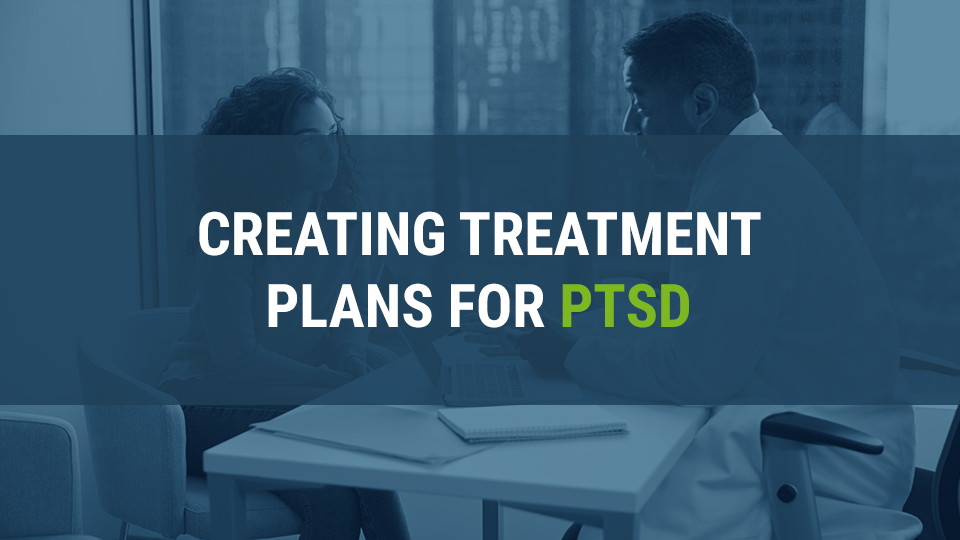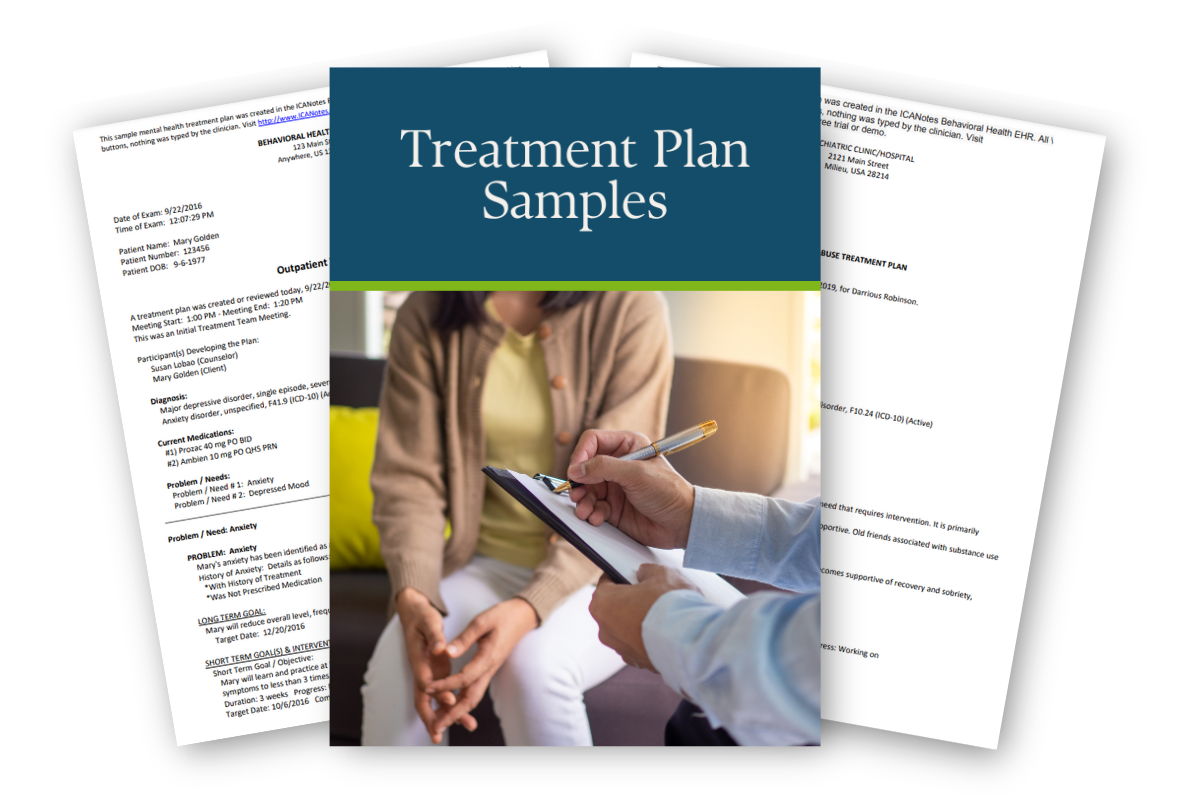Creating Treatment Plans for PTSD

Post-traumatic stress disorder (PTSD) happens after someone experiences or witnesses a traumatic event, such as domestic violence, war, a terrorist attack, or sexual assault, or it can occur after repeated exposure to horrific experiences. More than half of adults experience PTSD in their lives. PTSD has gone by many names, including shell shock after WWI and combat fatigue following WWII.
Regardless of its name, PTSD manifests in the same way. Common PTSD symptoms include:
- Nightmares
- Traumatic flashbacks
- Fear, anger, and sadness
- Detachment from others
Therapists treating this condition should create treatment plans for PTSD, which should describe patient symptoms, evaluate the best course of action for treatment, establish a timeline to achieve goals, and enact a method for therapists and patients to measure progress. A PTSD treatment plan comes with many benefits, including guiding treatment, reducing fraud by documenting all services, and facilitating potential patient transfers to a new therapist.
Below, we'll discuss what a PTSD treatment plan should include and how to keep solid documentation.
View Our Sample Treatment Plans
Get instant access to our full library of sample treatment plans.


Identify the Cause of PTSD
PTSD has various causes depending on an individual's unique circumstances. Common causes of PTSD include traumatic events like physical or emotional assault, a threat with a weapon, an accident, or exposure to violent combat.
Although PTSD symptoms vary depending on the individual and their situation, they typically adhere to four categories:
- Intrusion: Intrusive thoughts include repeated negative flashbacks, memories, and nightmares. When people experience intrusive thoughts, they might feel like they're reliving a traumatic experience.
- Avoidance: People with PTSD may try to avoid people, situations, places, and objects that remind them of a traumatic event. Part of avoidance could include not wanting to speak about a traumatic event to avoid thinking about what happened.
- Cognition and mood alterations: PTSD can cause people to feel negative and distorted thoughts about themselves, their situation or others. They also could struggle to remember crucial details about the traumatic event. Distorted thinking could lead to someone who has PTSD unnecessarily blaming themselves or others. Common symptoms of alterations in mood and cognition include avoiding activities they previously enjoyed, being unable to experience positive emotions like happiness, feeling emotionally numb or feeling detached from loved ones.
- Changes in emotional arousal or reactivity: When people experience PTSD, they might encounter emotional changes such as reckless or self-destructive behavior, irritability, trouble with sleep or concentration, intense awareness of their surroundings, or easy startling.
After identifying whether a patient has PTSD based on their symptoms, you should determine what's caused it. While the causes of PTSD vary depending on each patient, common aspects that could exacerbate a patient's condition include:
- Extreme or repeated stress
- Early-life trauma such as physical or sexual abuse
- Family history of mental health issues
- Substance abuse issues, such as heavy drinking or drug use
- Lack of a solid support system of loved ones
- The patient's inherent personality features, often referred to as temperament
- Biological factors such as how a patient's brain responds to stressful stimuli and how the body regulates hormones
Set PTSD Treatment Goals and Objectives
The ultimate aim of creating treatment plans for PTSD is to help patients reach their goals while letting counselors monitor progress and make necessary adjustments. Part of crafting a PTSD treatment plan is to help patients set realistic goals and objectives for themselves. Although goals and objectives have similar purposes for patient recovery, they do have slight differences. While goals encompass general statements about what patients would like to achieve, objectives target specific skills patients must develop to reach their goals.
When patients set goals and achieve them through specific objectives, they can experience various benefits, including:
- More progress toward recovery
- Improved concentration and motivation
- Increased ability to set priorities
- Boosted self-confidence
- Fewer feelings of being overwhelmed
You can work with patients to set objectives to achieve their goals. First, talk with patients to help them identify unhealthy behaviors and establish goals. Then, you can help them reach those goals by breaking the process into objectives, which are easily digestible steps to change unproductive behaviors and adopt healthy ones.
Potential goals and their corresponding objectives include:
- Processing and working on abuse or neglect issues: Work with patients to help them review incidences of abuse or neglect. You should create a set number of strategies to cope with stimuli that trigger memories of stressful events.
- Working on anger and mood issues: You should help your patients have a favorable view of their life and future when working on mood and anger issues. Encourage positive self-talk to mitigate depression and help celebrate small achievements. Working with patients to set sleep goals can help stabilize their moods. You should also work with them to decrease suicidal thoughts and encourage them to call hotlines if they're experiencing such thoughts.
- Resolving anxiety: Anxiety often accompanies PTSD. You can help patients achieve their goals of managing anxiety by recognizing anxiety-provoking triggers. Further, patients can develop strategies to help build self-confidence and learn which daily situations stress them out.
- Improving behavioral issues through positive behavior: You can help encourage positive behaviors and moods by monitoring drug and alcohol abuse, discouraging patients from high-risk situations that could provoke anger or encouraging them to successfully complete household tasks.
- Communicating better with others: If your patient struggles with communicating with friends and family after a traumatic event, you could set goals to help them establish positive relationships. Objectives that can help patients better communicate include expressing feelings through words and without acting out, understanding behaviors that could cause relationships to fail, and managing physical aggression.
- Managing alcohol and drug abuse: Substance abuse is a symptom of PTSD. When helping patients achieve the goal of resolving drug and alcohol issues, you can work with them to create a PTSD treatment plan. Encourage them to avoid people or places that could spark temptation, and help them discover their triggers for substance abuse.
Use a PTSD Treatment Plan Template
Treatment plans for PTSD are collaborative between the patient and therapist, and they are individual to the patient. However, you can follow a standard template when crafting a PTSD treatment plan. Typical treatment strategies cover common categories, including:
- Patient information: On patient treatment plans, you should document standard patient information such as their name, date, insurance details, and their Social Security number.
- Diagnosis: Next, you'll want to include information about what a patient is experiencing and what is causing their symptoms to come to a diagnosis.
- Challenges and areas for improvement: In this section, report on the goals you've worked on with patients. At this stage of the treatment process, you should also set a specific objective for patients to achieve their goals. Typically, it would be best if you aimed to have at least three goals at any given time with patients.
- Interventions: Interventions should be specific to the patient, set within a particular time frame and measurable.
- Finalization and signatures: At this stage, the patient and clinician both review and sign the treatment plan in approval.
When crafting a PTSD treatment plan, you should first consider how patient problems align with the six problem domains. The domains include:
- Medical status
- Employment and financial support
- Substance abuse
- Legal status
- Family, economic, demographic, and social status
- Psychiatric status




